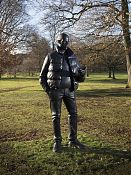Masculinity stripped to the core: Tom Price’s bronze sculptures of black men
He talks to Hannah Duguid about how his life has informed his art
26 January 2014
Tom Price makes bronze sculptures of black men. Sometimes his figures are naked, sometimes clothed. He plays with scale, making both enormous and small men. Sometimes he just makes a tiny head, with a perfect weave of corn rows across its gleaming scalp.
Price’s 9ft sculpture of a man wearing a sleeveless puffa jacket and jeans stands in the grounds of Bretton Hall at the Yorkshire Sculpture Park near Wakefield. Called Network, it’s made of bronze with a black patina, which looks like a silhouette in the landscape. Walking towards it is a disorientating experience. From a distance, a dark human-size figure dressed in urban fashion casually flicks a look at the screen on his mobile phone. But then he looms up suddenly and his size is intimidating. He’s tall and broad-shouldered, with a barrel chest and slight gut. There’s a moment of fear, but looking up into his downcast face, he appears vulnerable, lost within his own inner world. He’s made using the life-like language of 19th-century sculpture but without their idealised heroism. He reflects power and powerlessness at the same time. A commonplace subject – an ordinary urban man – cast in a valuable material and life-like form, which was once reserved for aristocrats and heroes.
Price’s work has a literary quality to it, with imagined narratives and empathy for who these characters might be. His figures are not portraits of a real people but invented characters. Always black men, made using the materials and methods of traditional sculpture. Historically, a bronze sculpture of a male denoted some degree of status, high achievers in a man’s world of war and politics. But Price’s figures feel rather lowly. He plays with ideas of how men are represented and perceived. How we feel when we look at each other, and the snap judgements we might make.
“They’re all men because I was looking at the ideal of the male type in classical sculpture. And at how Greek and Roman and neo-classical sculpture represented the male. Men had a higher social status and I wanted to infiltrate the idea of monumental sculpture and place within it a fictional character,” he says.
A series of small nudes, about two-feet high, stand on plinths in the indoor galleries. These figures have paunches and slouched postures, rather than the puffed-out and muscular chests of heroes. An inward gaze on their weary faces makes them appear sad. They seem older and could be mistaken for historical nudes until you notice a pair of cheap loafer shoes, or a bulky wristwatch, which shifts the figure into the present. These details humanise them, bringing them to life.
The plinths they stand on are antique but a layer of neon Perspex makes it clear the work is contemporary. They’re titled after streets in south London – Orpheus Street, Ducie Street – where Price used to live. These ordinary streets are inhabited by a mix of cultures and ethnicities.
Price, who lives in Clerkenwell, London, documents his interest in classical sculpture with a series of images made during his residency at the British School in Rome. His brown hands explore the pages of books of ancient sculpture; his fingers wrap around the stone face of a Roman statue, and an idealised female nude.
In the same room, a series of miniature heads stand on tiny, brightly coloured plinths. At first sight they could be artefacts in a museum – the kind of object a Victorian explorer might have brought back from travels in Africa. Except the faces express a degree of self-doubt which would not appear on an anthropological object. Some have corn rows in their hair, others appear terribly sad, world-weary and defeated.
The relationship between classical sculpture and black culture reflects an autobiographical element to Price’s work. He grew up mixed-race, half Jamaican and half white British, within a white family who lived in Hampshire and London.
“My upbringing set me up to have an awareness of how I look at people. I was always aware of being looked at, and what other people were seeing when they looked at me. It made me ask what that other person was thinking.
“The work is about coming to terms with understanding other people, how people read each other and form opinions of each other, which is influenced by my own experiences. With that interest, I added a racial and institutional element, which changes the angle of it. I’m playing a mischievous game to get people to ask questions,” says Price.
None of Price’s sculpture is life-size. Altering scale changes our perception, and defines them as fictional. Despite their details, we don’t experience them as real. “If they were literal figures, life-size and made in bronze, then I think they would fall short as sculpture,” he says.
His work now stands among monumental bronzes by Henry Moore and Barbara Hepworth, as well as more recent work by famous names such as Antony Gormley, Anthony Caro and Julian Opie.
“It’s like a dream to see it in this context, it’s as though it has infiltrated an institution,” he says. “It gives me the chance to see where my work has come from and where it’s going. It’s exciting for me to see what will come up next
